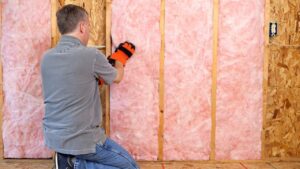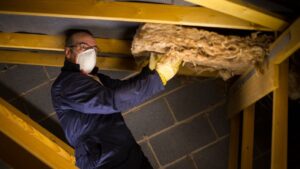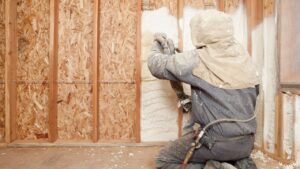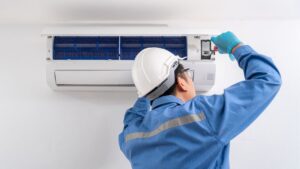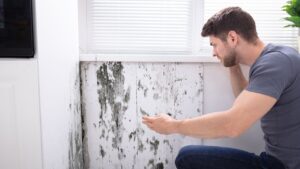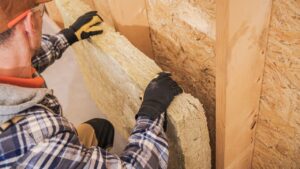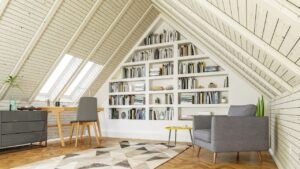Effective insulation is vital for ensuring optimal comfort and energy efficiency within your home. When it comes to insulating attics and roofs, several best practices and considerations can make a significant difference in the overall effectiveness of insulation.
In this blog, we will explore eight essential guidelines to help you optimize insulation in your attic and roof, ensuring improved energy efficiency, reduced heating and cooling costs, and increased comfort throughout your home.
8 Best Practices and Considerations for Insulating Your Roofs
The following practices are considered best when insulating your attics and roofs:
1. Assess the Existing Insulation
Before making any changes, it is crucial to assess the current insulation in your attic and roof. Determine the type, condition, and thickness of the insulation. This evaluation will help you identify areas that may require improvement or additional insulation.
If you have fiberglass batts, check for any signs of damage, sagging, or gaps. Insulation materials like cellulose or spray foam should be inspected for moisture damage or settling. By understanding the current state of your insulation, you can make informed decisions about the necessary steps to improve it.
2. Determine the R-Value
Understanding the R-value of insulation is vital. R-value measures the thermal resistance of the material and determines its insulating effectiveness. Different regions have varying recommended R-values, so it’s essential to consult local building codes or insulation experts to determine the appropriate R-value for your area.
For example, in Virginia Beach, the recommended R-value for attic insulation is typically R-38 to R-60, depending on factors such as climate and the age of your home. Higher R-values provide better insulation and energy efficiency. By ensuring your insulation meets the recommended R-value, you can optimize its performance.
3. Seal Air Leaks
Addressing air leaks in your attic and roof is crucial for maximizing insulation efficiency. Common areas for air leaks include gaps around pipes, electrical wires, vents, and chimneys. Use caulking or weatherstripping to seal these leaks, preventing air infiltration and heat loss.
Inspect the attic thoroughly for any cracks, gaps, or holes that could allow air to escape or enter the living spaces below. Pay close attention to areas where different building materials meet, such as around windows, doors, and junctions between walls and ceilings. By sealing these air leaks, you can ensure that your insulation works effectively.
4. Proper Ventilation
Maintaining adequate ventilation is vital to prevent moisture buildup and ensure proper airflow in your attic. Improper ventilation can lead to condensation, mold growth, and reduced insulation effectiveness. Consider installing ridge vents, soffit vents, or gable vents to promote airflow and improve the overall performance of your insulation.
Proper ventilation allows fresh air to circulate through the attic, preventing excessive heat buildup during hot summer months and minimizing moisture-related issues. It also helps remove stale air and prevents the accumulation of harmful pollutants. Consult with insulation professionals to determine the right ventilation system for your attic and roof.
5. Insulate Attic Access Points
Don’t overlook the importance of insulating attic access points, such as doors, hatches, or pull-down stairs. These areas can be significant sources of heat loss or gain. Insulating them with weatherstripping or insulation blankets can help maintain consistent temperatures in your home.
Attic access points often lack proper insulation, allowing air to flow freely between the attic and the living spaces. By insulating these areas, you can prevent energy loss and maintain a more comfortable indoor environment. Additionally, consider adding an insulated attic stair cover to reduce heat transfer and air leakage further.
6. Use Proper Insulation Materials
Choosing the right insulation material is crucial for optimal performance. Common types include fiberglass batts, cellulose, spray foam, and mineral wool. Consider factors such as R-value, moisture resistance, fire resistance, and eco-friendliness when selecting insulation materials.
Fiberglass batts are affordable and widely used, providing excellent thermal insulation. Cellulose insulation is made from recycled materials and offers good fire resistance. Spray foam insulation provides superior air-sealing properties and can be applied in hard-to-reach areas. Mineral wool insulation offers excellent sound absorption and fire resistance.
7. Insulate the Roof Deck
Insulating the roof deck, also known as a “hot roof” or “warm roof” system, can provide numerous benefits. It helps maintain a consistent temperature in the attic, prevents ice dams, and improves energy efficiency. Consult with insulation professionals to determine the most suitable insulation method for your roof type.
In a hot roof system, insulation is installed directly under the roof deck, eliminating any ventilation space between the insulation and the roof. This method ensures the entire roof structure is within the conditioned space of your home, minimizing temperature fluctuations and reducing the risk of ice dams forming along the eaves.
Proper installation of a hot roof system requires expertise and should be performed by insulation professionals. They can assess your roof’s structural integrity, evaluate the suitability of the method for your climate, and recommend the appropriate insulation materials.
8. Maintain Proper Clearance
Ensure that insulation does not come into direct contact with recessed lighting fixtures, as this can create a fire hazard. Leave a clearance of at least three inches around these fixtures and use protective covers or boxes specifically designed for insulation contact.
Recessed lighting fixtures generate heat, and if insulation is in direct contact with them, it can cause overheating and potentially lead to a fire. Maintaining proper clearance helps dissipate the heat and ensures safe operation. Install insulation baffles or extenders around the fixtures to maintain the necessary distance.
Conclusion
Insulating your attic and roof using the best practices and considerations mentioned above will not only enhance the energy efficiency of your home but also provide improved comfort and cost savings. By assessing your current insulation, sealing air leaks, using proper materials, and seeking professional assistance, you can create an environment that is well-insulated and optimized for energy conservation. If you’re looking for insulation companies near you, such as in Virginia Beach, make sure to consider these best practices and reach out to reputable professionals to ensure a successful insulation project. Remember, a well-insulated attic and roof are investments that pay off in the form of energy savings, increased comfort, and a more sustainable home environment.

